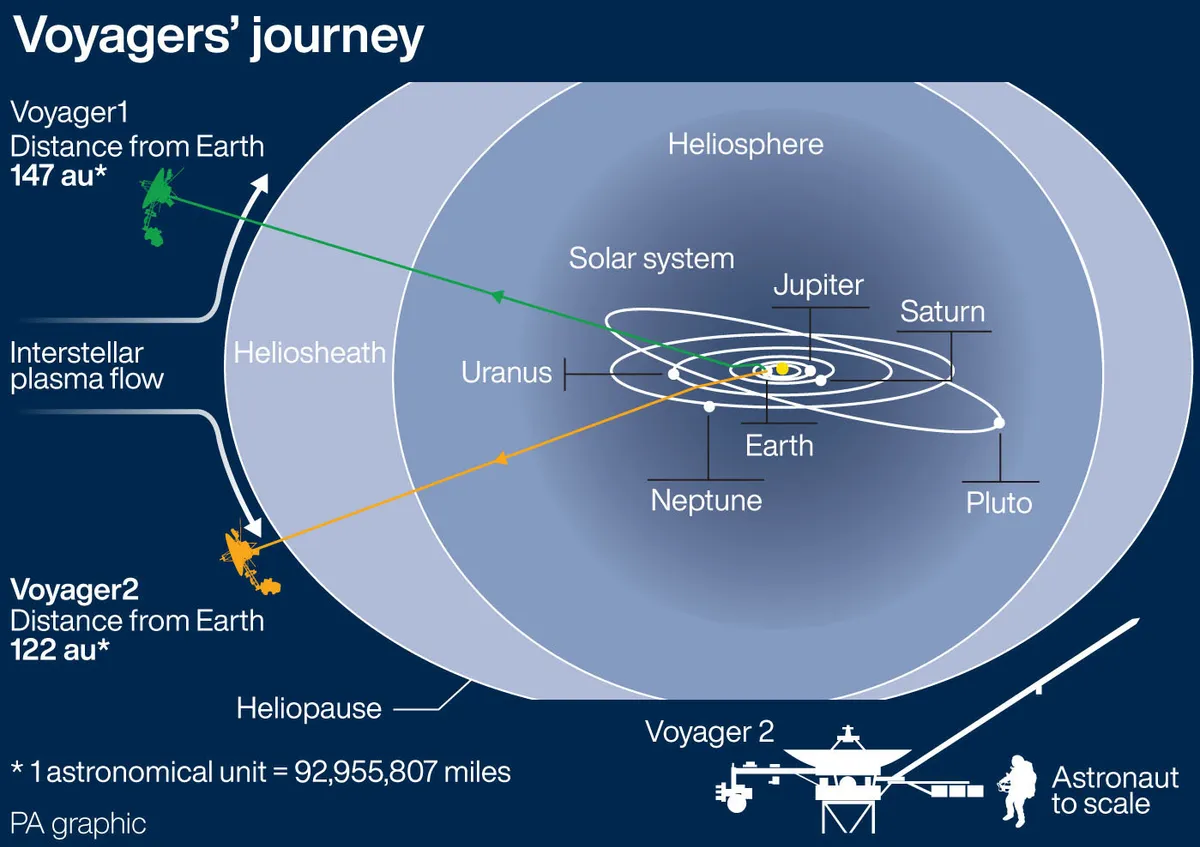Nasa’s Voyager 2 has reported back with its initial cosmic findings – a year after becoming the second man-made object to “leave” the Solar System.
The probe blasted off from Earth 42 years ago – 16 days before its twin spacecraft, Voyager 1 – and crossed the outer edge of the Sun’s protective bubble, known as the heliopause, on 5 November 2018.
It entered the interstellar medium – which is the region outside the heliopause made up of gas, dust and cosmic rays – 6 years after Voyager 1 due to its slower trajectory.
Read more about the Voyager mission:
- Everything you need to know about the Voyager mission
- A message to ET: 47 images from the Voyager Golden Record
- Mind-blowing things we learned watching the new Voyager film The Farthest
In a series of papers published in the journal Nature Astronomy, researchers confirmed the spacecraft’s journey into the “space between the stars” by noting a “definitive jump” in the density of the plasma – made up of charged particles and gas – in interstellar space.
According to the scientists, this jump was detected by one of the instruments on Voyager 2 and is evidence of the probe making its way “from the hot, lower-density plasma characteristic of the solar wind to the cool, higher-density plasma of interstellar space”.

It is also similar to the plasma density jump experienced by Voyager 1 when it crossed into interstellar space, the researchers added.
Among many things, the astronomers are looking to gain a better understanding of how the solar winds – the stream of charge particles coming out of the Sun – interact with the interstellar winds – made up of particles from other stars.
Dr Edward Stone, a professor of physics at the California Institute of Technology and former director of the NASA Jet Propulsion Laboratory, said: “We are trying to understand the nature of the boundary where these two winds collide.”
The astronomers believe the probes’ journeys – with their different mission goals and trajectories – give “valuable clues” about the structure of the heliosphere – a vast bubble encompassing the Sun and the Solar System.

Bill Kurth, a research scientist at the University of Iowa and one of the authors of the studies, said: “It implies that the heliosphere is symmetric, at least at the two points where the Voyager spacecraft crossed.”
In one of the papers, the researchers suggest that the interstellar medium near the heliopause is hotter than expected, with a temperature of around 30,000-50,000K (29,000-49,000C).
In another study, a different team reported the presence of layers “on both sides of the heliopause”.
While scientists were aware of the inner layer, the presence of the outer layer became evident only after Voyager 2 crossed into interstellar space.
The researchers said evidence gathered by both probes show that the interstellar medium, along with the heliopause and the interstellar magnetic fields, “form a complex interconnected dynamical system”.
The Voyagers were sent initially to study the outer planets including Jupiter, Saturn, Uranus and Neptune, but then just kept on going.
Even though they made it out of the Sun’s bubble, astronomers maintain that the Voyagers are still in the Solar System because it stretches to the outer edge of the Oort cloud – comprising water ice, ammonia and methane – which surrounds the Sun.
What’s on the Voyager probes?
The twin probes each weighed 722kg, full of scientific instruments, radio systems and their power sources. Solar energy was not an option given that Voyager 1 would be travelling 778 million km from the Sun, and Voyager 2 needed to be functional as far as 4.5 billion km from the Sun. The best alternative was nuclear power, in the form of Radioisotope Thermoelectric Generators (RTGs), containing plutonium-238 that would decay to produce heat, which was converted to electricity.
Each probe holds 11 instruments for analysis. These include examining atmospheric chemistry, magnetic fields, detecting aurorae, measuring charged particles, using radio signals to determine physical properties of the planets, and detecting solar wind through plasma measurements.
Both also carry a 'Golden Record', containing 116 analogue-encoded images, greetings in 55 languages, 12 minutes of natural sounds from Earth, and 90 minutes of music, chosen by Carl Sagan and SETI’s Frank Drake after collaborating with historians, artists, folklorists and ethnomusicologists to create the best first impression of our home planet.
Dr Stone said the crafts’ plutonium power sources will eventually stop supplying electricity, at which point their instruments and their transmitters will die.
He added: “In another 5 years or so we may not have enough scientific instruments to power it any longer.”
Dr Kurth believes that both Voyagers “will outlast Earth”, adding: “They’re in their own orbits around the galaxy for 5 billion years or longer.
“And the probability of them running into anything is almost zero.”
